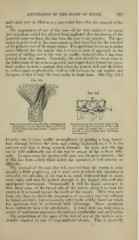Page 981 - My FlipBook
P. 981
AMPUTATION OF THE ROOTS OF TEETH. 991
and which may be filled at any convenient time after the removal of the
root.
The amputation of one of the roots of the first molar of the lower
jaw is perhaps called for oftenest from neglected alveolar abscess of the
posterior root—at least, this has been the case in my practice. The ope-
ration is performed by the same means as that described for the removal
of the palatine root of the upper molar. The operation, however, is rather
more difficult, for the reason that it is not so easy of aj)proach in the
process of cutting, nor is the root so readily removed after it has been
severed from the crown. Generally, the root should be cut as close to
the bifurcation of the roots as possible and sloped down toward the prox-
imal surface in such a manner that when the gum is well and shrunken
as wide a space as practicable shall be left between the cut surface and
the gum, so that it may the more easily be kept clean. (See Fig. 531.)
Fig. 530.
Case represented in Fig. 529 after Treatment by Amputation of the Posterior Root of the
Amputation of the alfected Root and filling first Lower JNIolar (the roots of the teeth
of the Pulp-cavitv and Canals. (Compare with are shown by dotted lines): a, root re-
Fig. 529.) moved; h, line of g"um after shrinkage
has occurred.
Usually this is most readily accomplished by passing a long fissure-
burr through between the I'oots and cutting backward, or, if it is the
anterior root that is being severed, forward. In most cases the lips
can be held sufficiently out of the way to permit of this without diffi-
culty. In some cases the incision wnll open into the j)ulp-chamber ; but
if this has been solidly filled before the operation, it will occasion no
difficulty.
The removal of the root after it is severed from the crown is occa-
sionally a little perplexing, yet in most cases in which this operation is
advisal)le the alveolus of the root is so much destroyed that it comes
away easily and may be pushed through to the lingual side with any
appropriate instrument. Occasionally it will be found necessary to
burr away some of the buccal side of the root to allow it to clear the
crown as it is turned toward the inside of the mouth. These two posi-
tions are those in Avhich the amputation of an entire root will oftenest
be found available, but occasionally other teeth will be found on which
the operation may be performed with advantage. These operations
have uniformly been very satisfactory. A tooth that has long been a
source of continuous annoyance is rendered comfortable and serviceable.
The amputation of the apex of the root of any of the teeth is occa-
sionally required in case of long-neglected abscess. This is generally


